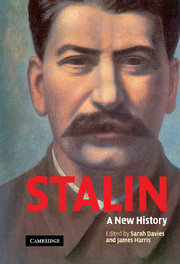Book contents
- Frontmatter
- Contents
- Notes on contributors
- Preface
- A note on transliteration
- Glossary
- 1 Joseph Stalin: power and ideas
- 2 Stalin as Georgian: the formative years
- 3 Stalin as Commissar for Nationality Affairs, 1918–1922
- 4 Stalin as General Secretary: the appointments process and the nature of Stalin's power
- 5 Stalin as Prime Minister: power and the Politburo
- 6 Stalin as dictator: the personalisation of power
- 7 Stalin as economic policy-maker: Soviet agriculture, 1931–1936
- 8 Stalin as foreign policy-maker: avoiding war, 1927–1953
- 9 Stalin as Marxist: the Western roots of Stalin's russification of Marxism
- 10 Stalin as Bolshevik romantic: ideology and mobilisation, 1917–1939
- 11 Stalin as patron of cinema: creating Soviet mass culture, 1932–1936
- 12 Stalin as producer: the Moscow show trials and the construction of mortal threats
- 13 Stalin as symbol: a case study of the personality cult and its construction
- 14 Stalin as the coryphaeus of science: ideology and knowledge in the post-war years
- Index
7 - Stalin as economic policy-maker: Soviet agriculture, 1931–1936
Published online by Cambridge University Press: 24 November 2009
- Frontmatter
- Contents
- Notes on contributors
- Preface
- A note on transliteration
- Glossary
- 1 Joseph Stalin: power and ideas
- 2 Stalin as Georgian: the formative years
- 3 Stalin as Commissar for Nationality Affairs, 1918–1922
- 4 Stalin as General Secretary: the appointments process and the nature of Stalin's power
- 5 Stalin as Prime Minister: power and the Politburo
- 6 Stalin as dictator: the personalisation of power
- 7 Stalin as economic policy-maker: Soviet agriculture, 1931–1936
- 8 Stalin as foreign policy-maker: avoiding war, 1927–1953
- 9 Stalin as Marxist: the Western roots of Stalin's russification of Marxism
- 10 Stalin as Bolshevik romantic: ideology and mobilisation, 1917–1939
- 11 Stalin as patron of cinema: creating Soviet mass culture, 1932–1936
- 12 Stalin as producer: the Moscow show trials and the construction of mortal threats
- 13 Stalin as symbol: a case study of the personality cult and its construction
- 14 Stalin as the coryphaeus of science: ideology and knowledge in the post-war years
- Index
Summary
This chapter examines Stalin's role in agriculture in 1931–6 in the context of the general development of Soviet agricultural policy. It is based primarily on the correspondence exchanged between Stalin and Kaganovich, Stalin's deputy in Moscow during his fifty-six weeks of vacation in these six years. The correspondence comprises some 850 letters and coded telegrams. During his vacation Stalin also received a large packet of documents eight to twelve times a month via the courier service of the OGPU/NKVD; lists of these documents are also now available. The correspondence and the lists of documents provide a unique opportunity to examine his behaviour as a political leader. This vacation material has been supplemented by the protocols (minutes) of the Politburo and Stalin's appointments diary for the much longer period when he was not on vacation, by the telegrams he sent while he was in Moscow (available far less systematically), and by his published writings and speeches.
Before examining the Stalin–Kaganovich correspondence, I sketch out the background up to 1930, and the main features of agricultural policy in 1931–6.
Background
The Bolsheviks took it for granted that, in the long term, the way forward for agriculture in peasant countries like Russia was to replace individual household economies by large-scale mechanised farms.
- Type
- Chapter
- Information
- StalinA New History, pp. 121 - 139Publisher: Cambridge University PressPrint publication year: 2005
- 1
- Cited by



